MORE FROM SCOTLAND MAGAZINE
The Red Duchess: Scotland’s first female MP
A hundred years after becoming Scotland’s first female MP, we tell the remarkable life story of Kitty, Duchess of Atholl, one of the past residents of Blair Castle, Perthshire
Words by Henrietta Easton
Looking at baronial Blair Castle, with all its medieval-style turrets and crenellations, standing spectacularly amid the greenery of Glen Garry, Perthshire, it seems obvious that the grand house is the kind of place that would have nurtured politicians, entrepreneurs, soldiers, agriculturalists, and philanthropists over the centuries.
Home to the Atholl family for over 700 years, Blair Castle is the ancestral home of Clan Murray and is the historic seat of their chief, the Duke of Atholl.

The castle started life in 1269 as Comyn’s Tower, built by Lord Badenoch, who started building on the Earl of Atholl’s land while he was away on Crusade. The Earl, upon his return, complained to the king and won back his land, incorporating Comyn’s Tower into his own castle.
The Earl of Atholl title switched hands for a few centuries until 1629, when it was returned to the Murray family, where it has remained ever since. The title Duke of Atholl was granted to the 2nd Marquess of Atholl in 1703. After this, the castle stood as a proud Georgian House for around a century, commissioned by the 2nd Duke, until the 19th century, when the 7th Duke began work to remodel the exterior of the castle into the increasingly popular Scottish Baronial style, and it is his vision that we see today.
The magnificently medieval-inspired entrance hall houses an incredible display of weapons, including shields and muskets used at the Battle of Culloden. From here, guests will want to take their time to admire the beautiful ballroom with its intricate vaulted ceiling that was designed for the Atholl Highlanders, who are probably Blair Castle’s most famous asset.
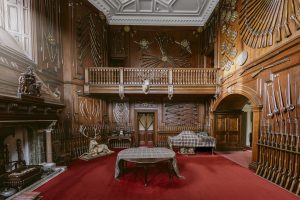
The Atholl Highlanders form the only remaining private army in Europe, acting as the personal bodyguard to the Duke of Atholl. The ballroom has been used for the annual Atholl Highlanders ball for over 150 years.
The Atholl Highlanders ball is also the setting for the beginning of the story of one former resident, whose life and legacy is still keenly celebrated around the castle. The story starts 36 miles away in Bamff House, Alyth, Perthshire, where Katharine Ramsay was born in 1874. ‘Kitty’ as she was affectionately known, was a daughter of the well-respected Ramsay family, and, along with her mother, she was first invited to Blair Castle in 1896 to attend the annual Atholl Gathering. It was here that she met Lord Tullibardine, heir to the 7th Duke of Atholl, or ‘Bardie’ as he was known – her future husband.
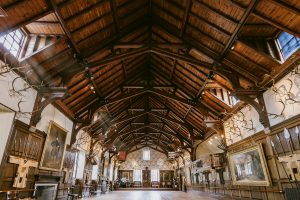
More interested in her music studies, (she had attended the Royal College of Music and was a keen pianist) Kitty was not eager to attend the ball, and took her music, books, and bicycle with her in protest.
“Riding around the castle on her bicycle, the Duke was rather taken with her as she was an unusual girl for those days”, says Sarah Troughton, half-sister of the late 10th Duke of Atholl, and previous Head Trustee of the estate. Bardie was fascinated by the independent, strong-willed, and clever Kitty, and a love affair between them began, with the pair marrying in July 1899.
“Being a concert pianist wouldn’t have worked with being a Duke’s wife, so Kitty gave up her musical ambitions and instead threw herself into all sorts of local projects,” Sarah says.
“When the First World War broke out, Kitty went out to Egypt with Bardie and helped a lot of the nurses. She also used to give informal concerts to the troops, to keep up morale”. When Bardie’s father died, the pair rushed back to Scotland to take on their new roles as Duke and Duchess. The castle, as was the fate of many similar houses, had been requisitioned as a recuperation home for injured soldiers, and, Sarah says, Kitty threw herself into that too, “she was very good at talking to people and being sympathetic.”
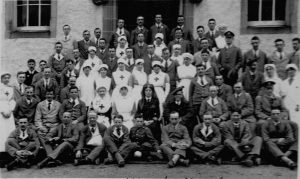
Kitty’s passion for welfare politics and a growing interest in foreign affairs fuelled her work, and despite, surprisingly, serving as Vice-President on the Anti-Suffrage League in Dundee in 1913, in 1923 she became MP for Kinross and West Perthshire – Scotland’s first female MP.
“That was quite remarkable for a woman,” Sarah says.
“Despite her sex, she did well in Parliament and was made the Minister of State for Education – the first female Minister of State.
“It was a time when women weren’t expected to do much, especially women of her class. Some of the older men in Parliament weren’t overly pleased with her, but that was no surprise,” Sarah adds.
With a particular concern for the wellbeing of women and children, Kitty was not afraid to raise controversial topics in Parliament. She spoke to a Parliament of men about female circumcision and established a committee to investigate it – FGM was finally made illegal in Britain in 1985. “She had a very strong social conscience”, Sarah says.
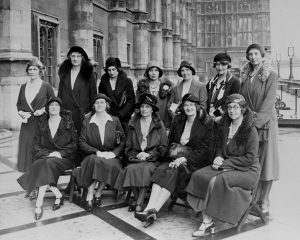
One of her most important legacies was her work in the Spanish Civil War, which broke out in 1936, as a struggle between democracy and Fascism.
Having travelled to Spain with two female MPs to see for themselves the conditions that people were living in, Kitty was shocked by the destruction the fighting had caused. She was instrumental in helping 4,000 children come to Britain from Spain to escape the fighting, and even wrote a book about her experiences called Searchlight on Spain.
Although Britain was neutral and the people Kitty helped came from both fighting sides, it was well known that Kitty’s sympathies were with the Republicans.
“She was nicknamed the Red Duchess,” Sarah says. “The press chose to say she was a Communist. Really, she was just a humanitarian.”
The Red Duchess’s strong social conscience continued to spur on her work as tensions rose in Europe leading up to the Second World War. Kitty, who had read Hitler’s Mein Kampf in its original German, could see that the English version had been signifiantly watered down. She spoke to fellow politicians about her concerns for Hitler’s ideologies and plans for the future of Germany, even producing an accurate English translation of the book.
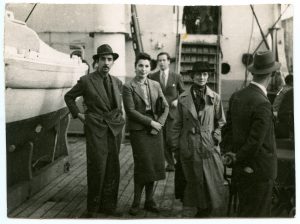
With the British government heading towards appeasement, and Kitty’s warnings about Hitler being ignored, she became increasingly impatient. Remaining true to her morals, she was one of just two Conservative MPs who resigned in protest. The other was Winston Churchill.
Her resignation sparked a local election and Kitty stood as an independent, though she was not re-elected. In a nasty campaign from the local Conservative party, Kitty was even sent a hoax telegram that said, ‘Best wishes, hope you do well’, signed from Stalin. Sadly, her predictions about Hitler proved true when Hitler invaded Poland nine months later.
Though she was no longer an MP, Kitty’s work helping others continued throughout the war, with Blair Castle becoming a home for evacuees from Glasgow. She still maintained a healthy interest in politics and was often called upon for her views by newspapers.
Her love of music didn’t stop either. “She kept up music all her life”, Sarah says. “I remember going to see her play as a small child, and I was always amazed because she could play absolutely anything by ear. She would just go to the piano and strum away.
“She was charming to me as a child,” Sarah recalls. “She was always in spats, which I’d never seen before – she must have been one of the last women to go on wearing them.”
Duchess Kitty died in 1960 and is buried in the family plot at Blair Castle. Her grave can be visited today.
When asked what Kitty’s most important legacy was, Sarah says: “To me, it was proving that women could be very useful in an important political role. She helped the feminist cause in this way. She was a trailblazer in that respect.”
A century after she became an MP, in 2023 Kitty’s legacy as one of Scotland’s fiercest women, brave, and true to her morals in a world ruled by men, continues to live on.
A special exhibition room at Blair Castle explores Kitty’s life. Tickets are included with general admission. On 8 December 2023 a musical celebration of Kitty’s life will take place. You can buy tickets at atholl-estates.co.uk/blair-castle
Read more:

SCOTLAND MAGAZINE
Published six times a year, every issue of Scotland showcases its stunning landscapes and natural beauty, and delves deep into Scottish history. From mysterious clans and famous Scots (both past and present), to the hidden histories of the country’s greatest castles and houses, Scotland‘s pages brim with the soul and secrets of the country.
Scotland magazine captures the spirit of this wild and wonderful nation, explores its history and heritage and recommends great places to visit, so you feel at home here, wherever you are in the world.












